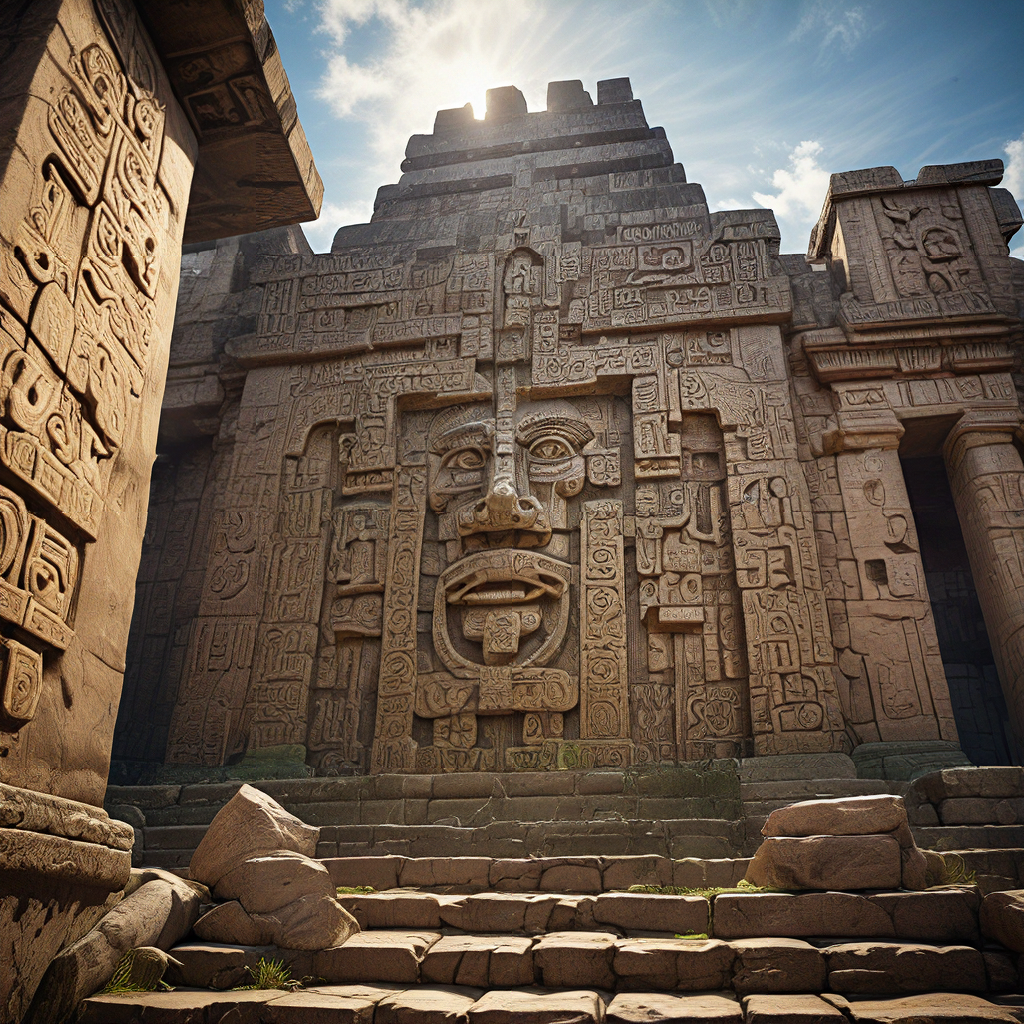The Serpent in Andean Mythology
In Andean mythology, the serpent is a powerful and multifaceted symbol that holds deep cultural and spiritual significance. Across various cultures and languages in the Andes, the serpent is known by different names, each embodying distinct attributes and roles. These names include "Amaru" in Quechua, "Yacumama" in some Amazonian languages, and "Machacuay" in the context of the Inca Empire. While their names and appearances may differ, these serpentine beings generally represent forces of nature, fertility, and the connection between the earthly and the supernatural realms.
The Temple of the Serpent: A Sacred Space
The Temple of the Serpent, often referred to as the "Temple of the Sun Serpent," is a mythical structure deeply embedded in Incan lore. While its exact location remains shrouded in mystery, the temple is said to have been a monumental complex dedicated to the worship of a serpent deity. This deity, often depicted as a giant serpent with scales of gold and emerald, embodied the forces of creation, transformation, and the cyclical nature of time. It is believed that the temple held immense power and was a central point for religious ceremonies and rituals.
The Serpent as a Symbol of Transformation
The serpent's association with transformation is rooted in its ability to shed its skin, symbolizing renewal, rebirth, and the cyclical nature of life. In Andean mythology, the serpent represents the journey of the soul through different stages of existence. It represents the transformation from the physical realm to the spiritual realm, and vice versa. This symbolism is highlighted in the serpent's role in creation myths, where it often acts as a bridge between the worlds, facilitating the creation of life and the establishment of order.
The Serpent’s Role in Creation Myths
In many Andean creation myths, the serpent plays a crucial role in the emergence of the world. It is often depicted as a powerful force that shapes the landscape, creates mountains, and brings forth life. For instance, in the myth of Viracocha, the creator deity transforms himself into a serpent to create the earth and its inhabitants. The serpent's ability to travel between the heavens and the earth, and its association with water, further reinforces its role as a creator deity.
The Temple’s Connection to the Underworld
The Temple of the Serpent is also believed to have been connected to the underworld, a realm of spirits and ancestors. This connection is evident in the serpent's association with the earth and its ability to move beneath the surface. The temple may have served as a portal to the underworld, allowing communication with the deceased and seeking guidance from ancestral spirits. The serpent's presence in the temple therefore signified the continuity of life and the interconnectedness of the physical and spiritual realms.
The Temple’s Connection to the Underworld
The Temple of the Serpent is also believed to have been connected to the underworld, a realm of spirits and ancestors. This connection is evident in the serpent's association with the earth and its ability to move beneath the surface. The temple may have served as a portal to the underworld, allowing communication with the deceased and seeking guidance from ancestral spirits. This connection to the underworld is reflected in the serpent's association with water, a powerful element often linked to the realm of the dead in many cultures. The serpent's presence in the temple therefore signified the continuity of life and the interconnectedness of the physical and spiritual realms.
The Temple as a Site of Ritual and Sacrifice
The Temple of the Serpent was a place of intense religious activity. It is believed that priests and shamans performed elaborate rituals and sacrifices to appease the serpent deity and gain its favor. These rituals likely involved offerings of food, precious metals, and even human sacrifices. The serpent's connection to fertility and abundance made it a powerful deity to invoke for agricultural prosperity and protection from natural disasters. The rituals performed at the temple were deeply intertwined with the cycles of nature, reflecting the importance of balance and harmony in the Inca worldview.
The Serpent’s Association with Fertility and Abundance
Beyond its role in creation myths and the underworld, the serpent was also associated with fertility and abundance. This association stems from the serpent's connection to the earth, its ability to produce offspring, and its association with water, a vital resource for agriculture. The serpent's shedding of its skin is also seen as a symbol of renewal and regeneration, further reinforcing its link to fertility. In the Inca Empire, the serpent was worshipped as a protector of crops and livestock, ensuring bountiful harvests and the prosperity of the community.
The Temple’s Role in the Inca Social Structure
The Temple of the Serpent played a crucial role in shaping the Inca social structure. The temple was a center of power and authority, its priests wielding considerable influence over the people. The temple's priests were responsible for interpreting the will of the serpent deity and guiding the Inca rulers in their decisions. Their knowledge of rituals, ceremonies, and the interpretation of omens was highly valued and respected. The temple also served as a gathering place for the community, fostering a sense of unity and shared belief in the serpent deity.
Theories on the Temple’s Construction and Purpose
Despite the lack of concrete archaeological evidence, theories abound about the Temple of the Serpent's construction and purpose. Some scholars believe that the temple may have been built on a natural formation resembling a serpent, while others suggest that it was an elaborate complex made of stone and adorned with gold and precious metals. The temple's purpose is also debated, with some scholars proposing that it was a place of worship, while others believe it may have been a tomb for Inca rulers or a site for astronomical observations. The mysteries surrounding the Temple of the Serpent continue to fascinate historians and archaeologists, fueling ongoing research and exploration.
The Temple’s Legacy and Modern Interpretations
Despite being a mythical structure, the Temple of the Serpent has left a lasting legacy on Andean cultures. It continues to be a source of inspiration for artists, writers, and scholars, who explore its symbolism and its role in Andean history and mythology. The serpent's connection to transformation, fertility, and the underworld resonates with modern audiences, reflecting a universal desire for understanding the mysteries of life, death, and the interconnectedness of the natural and spiritual realms.
FAQ
What is the Temple of the Serpent?
The Temple of the Serpent, also known as the Temple of the Sun Serpent, is a mythical structure deeply embedded in Incan lore. It is believed to have been a monumental complex dedicated to the worship of a serpent deity.
Where is the Temple of the Serpent located?
The exact location of the Temple of the Serpent is unknown and remains shrouded in mystery.
What is the significance of the serpent in Andean mythology?
The serpent is a powerful and multifaceted symbol in Andean mythology, representing forces of nature, fertility, and the connection between the earthly and the supernatural realms. It is associated with transformation, renewal, and the cyclical nature of life.
What is the connection between the Temple of the Serpent and the underworld?
The Temple of the Serpent is believed to have been connected to the underworld, a realm of spirits and ancestors. The serpent's association with the earth and its ability to move beneath the surface reinforces this connection.
What is the role of the serpent in creation myths?
In many Andean creation myths, the serpent plays a crucial role in the emergence of the world. It is often depicted as a powerful force that shapes the landscape, creates mountains, and brings forth life.
What was the purpose of the Temple of the Serpent?
The Temple of the Serpent was a place of intense religious activity, where priests and shamans performed rituals and sacrifices to appease the serpent deity and gain its favor. It also played a crucial role in shaping the Inca social structure.
What is the legacy of the Temple of the Serpent?
The Temple of the Serpent, despite being a mythical structure, has left a lasting legacy on Andean cultures. It continues to be a source of inspiration for artists, writers, and scholars, who explore its symbolism and its role in Andean history and mythology.



